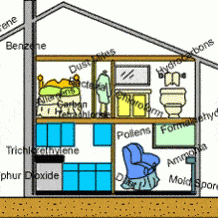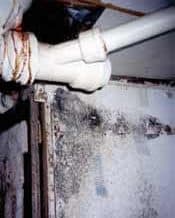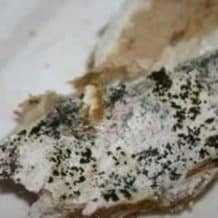How to Avoid Sick-House Syndrome

Although we all know that fresh air is good for us, we tend to associate it with spending time outdoors. Since many of us spend most of our lives indoors, we should educate ourselves on the danger of what is called “sick-house” syndrome. This occurs when our homes, offices, etc. are sealed tightly to prevent noise, pollution, or cold air from entering. Unfortunately, this also prevents harmful fumes caused by paints, cleaning products, deodorizers and wood smoke from getting out. Even our furnishings, carpeting, and clothing can emit dangerous pollutants.
Image: Invisible toxins may be throughout your home, causing sick-house syndrome.
Studies show that the air in our homes should be changed ten times per day – anything less causes build up of dangerous pollutants. Below are some tips to help avoid Sick-House Syndrome. First, open the windows (just a crack is sufficient) when possible, and check to make sure that all vents are unblocked.
Another problem that lack of ventilation can cause is mold and mildew. This is found to be a danger not only to your health, but it can also damage the structure of your house. Especially in rooms such as kitchens and bathrooms, where humidity is likely to be high, proper ventilation is essential. The use of fans in these areas are helpful.
Also, check areas such as the attic and underneath floors for proper air circulation. If you have a humidity problem upstairs, it probably means that the attic or roof space needs more ventilation. Be aware that some types of flooring can sustain structural damage if there is not adequate ventilation beneath it.
We all want our homes to smell nice, and a clean, well-ventilated house will. But unpleasant odors happen, and we should not become overzealous in using artificial scents that add more pollutants to the air. Aerosols, in particular, are not eco-friendly and often contain nasty additives that contribute to allergies and even lung damage. Do not fall into the trap of trying to create a “fresh smelling” home by adding more chemicals to your already polluted air.
You can easily make your own room deodorizer by sprinkling a few drops of vanilla or essential oil on a cotton ball. Place this in a small open container to prevent the oil or alcohol from damaging your furniture. Other natural room fresheners to use include baking soda, white vinegar, fresh or dried herbs, or even a bowl of fresh apples. And, if you like the scent of fresh flowers, treat yourself to the real thing instead of using an artificial spray. Try to keep chemical-laced cleaners and perfumed products to a minimum, and use natural products as much as possible.
If you or your loved ones suffer from unexplained drowsiness, headaches or a general malaise, try getting fresher air through the house. Your family and your home with breath easier and you can avoid the “sick-house” syndrome.
Next : Air Purification Solutions
read more







